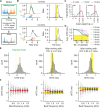Developmental fine-tuning of medial superior olive neurons mitigates their predisposition to contralateral sound sources
- PMID: 38683852
- PMCID: PMC11081505
- DOI: 10.1371/journal.pbio.3002586
Developmental fine-tuning of medial superior olive neurons mitigates their predisposition to contralateral sound sources
Abstract
Having two ears enables us to localize sound sources by exploiting interaural time differences (ITDs) in sound arrival. Principal neurons of the medial superior olive (MSO) are sensitive to ITD, and each MSO neuron responds optimally to a best ITD (bITD). In many cells, especially those tuned to low sound frequencies, these bITDs correspond to ITDs for which the contralateral ear leads, and are often larger than the ecologically relevant range, defined by the ratio of the interaural distance and the speed of sound. Using in vivo recordings in gerbils, we found that shortly after hearing onset the bITDs were even more contralaterally leading than found in adult gerbils, and travel latencies for contralateral sound-evoked activity clearly exceeded those for ipsilateral sounds. During the following weeks, both these latencies and their interaural difference decreased. A computational model indicated that spike timing-dependent plasticity can underlie this fine-tuning. Our results suggest that MSO neurons start out with a strong predisposition toward contralateral sounds due to their longer neural travel latencies, but that, especially in high-frequency neurons, this predisposition is subsequently mitigated by differential developmental fine-tuning of the travel latencies.
Copyright: © 2024 Sierksma, Borst. This is an open access article distributed under the terms of the Creative Commons Attribution License, which permits unrestricted use, distribution, and reproduction in any medium, provided the original author and source are credited.
Conflict of interest statement
The authors have declared that no competing interests exist.
Figures




Similar articles
-
A Test of the Stereausis Hypothesis for Sound Localization in Mammals.J Neurosci. 2017 Jul 26;37(30):7278-7289. doi: 10.1523/JNEUROSCI.0233-17.2017. Epub 2017 Jun 28. J Neurosci. 2017. PMID: 28659280 Free PMC article.
-
Medial superior olive in the rat: Anatomy, sources of input and axonal projections.Hear Res. 2024 Aug;449:109036. doi: 10.1016/j.heares.2024.109036. Epub 2024 May 25. Hear Res. 2024. PMID: 38797037
-
Envelope coding in the lateral superior olive. II. Characteristic delays and comparison with responses in the medial superior olive.J Neurophysiol. 1996 Oct;76(4):2137-56. doi: 10.1152/jn.1996.76.4.2137. J Neurophysiol. 1996. PMID: 8899590
-
The lateral superior olive: a functional role in sound source localization.Neuroscientist. 2003 Apr;9(2):127-43. doi: 10.1177/1073858403252228. Neuroscientist. 2003. PMID: 12708617 Review.
-
Sound localization.Handb Clin Neurol. 2015;129:99-116. doi: 10.1016/B978-0-444-62630-1.00006-8. Handb Clin Neurol. 2015. PMID: 25726265 Review.
References
Publication types
MeSH terms
LinkOut - more resources
Full Text Sources

